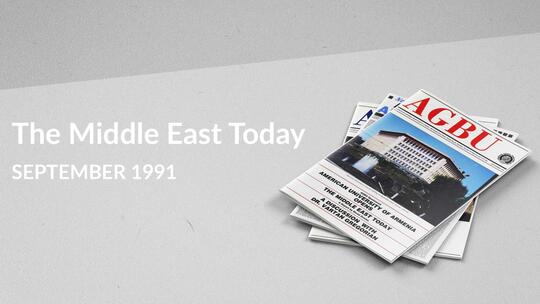by David Zenian
BEIRUT- After more than 15 years of fighting and bloodshed, a new spirit of hope and national reconciliation is surging in Lebanon and for once optimists seem to outnumber the pessimists.
Most Lebanese seem convinced that violence has failed to settle old scores. They also seem convinced that there is no alternative to the Syrian solution for a conflict which has withstood hundreds of cease-fires and nearly a dozen major agreements and attempts at a settlement.
The effects of the conflict - which started in 1975 and ended with the defeat in October 1990 of the last of the opponents of Pax-Syriana - on a small country such as Lebanon have been devastating.
The estimates of casualties of the Lebanese conflict vary; a relatively conservative figure would put the number of dead at 120,000 and of wounded at 300,000, which means that 4.5 percent of the resident population was killed and 11.5 percent wounded.
To this should be added the fact that over 1.2 million Lebanese have been forcefully displaced from their regions, often several times.
In southern Mount Lebanon, the Lebanese Christians constituted 55 percent of the population in 1975. Today, they are a mere 5 percent. In West Beirut, the percentage of Christians has dropped from 35 percent in 1975 to five percent now, the Bekaa Valley from 40 percent to 15 and South Lebanon from 26 percent to 10 percent.
The same is true with the country's Moslem population.
In the Eastern Beirut suburbs, the percentage of Moslems has dropped from 40 percent in 1975 to a meager five percent now, while in East Beirut proper, the percentage of Moslems has dropped from eight to one percent in the same period.
The demographic shifts are coupled with another dangerous and devastating factor. Over 800,000 Lebanese have emigrated since 1975; and the country's natural growth rate has dramatically declined. While emigration is not a new phenomenon for Lebanon, the violence over the past decade and a half has triggered an unprecedented exodus toward Canada, Australia, certain Arab and African countries, France and the United States. From a yearly average of about 5,000 in the early 1950's and 1960's, emigration rose to 10,000 in the early 1970's, to an average of 40,000 for the years between 1975 and 1988, and finally exceeded 70,000 in 1989 and 100,000 in 1990.
According to the most recent statistics, a combination of these factors has resulted in a zero growth rate of the Lebanese population during the last 15 years. the number of Lebanese residents in 1988 was estimated at 2.5 million, which is approximately the same figure as that in 1975. According to demographic projections made in the early 1970's , the Lebanese population should have naturally exceeded 3.5 million in 1990.
If the war has shattered the population growth, it has also had devastating effects on the nation's economy. Beyond the sheer destruction of factories, housing, hotels, and other facilities and the severe damage to the country's infrastructure, the war has effectively weakened Lebanon's once coveted role as a financial, trade, transit and recreational center in the Arab world.
Most of the work force has fled, hundreds of small businesses and larger factories have been destroyed, foreign banks have closed and the exchange rate with the dollar has plummeted from 3.4 Lebanese pounds to the dollar in 1975 to 860 Lebanese pounds in August this year.
This, in turn, has triggered not only rampant inflation, but also a new trading structure based on the U.S. dollar rather than the weak Lebanese pound.
The price of such goods as shoes, clothing, cosmetics, television sets and other electronic equipment are displayed in shop windows in dollars rather than Lebanese pounds.
Payrolls are still in Lebanese pounds, but the real money on the market is the dollar ... and so are the prices.
As may be expected, the lower and middle socioeconomic strata has suffered most from this economic collapse. Two indicators illustrate the dramatic decline in their standard of living.
The minimum monthly wage, which now stands at the equivalent of under 100 dollars a month before taxes, represents only about 35 percent of its level in 1974. The rate of unemployment, another major economic indicator, has jumped from eight percent in 1975, to 12 percent in 1980, and nearly 40 percent now.
In the space of a mere decade and a half, Lebanon has plunged dramatically from among the wealthiest to among the poorest of third World countries.
Many Lebanese still cannot comprehend this dramatic reversal, let alone cope with it in their daily struggle for survival.
There are no official estimates concerning the economic costs of the war, but according to a recent study prepared by the Arab Development Fund, Lebanon's reconstruction needs at least 20 billion dollars.
At the moment neither the oil-rich Arab countries nor the west seem ready to pour in the much needed cash to rebuild Lebanon, but true to their character, the Lebanese are not discouraged.
Private enterprise and a free market economy are at work. Factories are being repaired, hotels built, apartments put together and dozens of restaurants and places of entertainment opened.
Lebanon is telling the world that it has not only survived one of the longest civil wars in the Middle East, but that it also has not lost its will to live.






